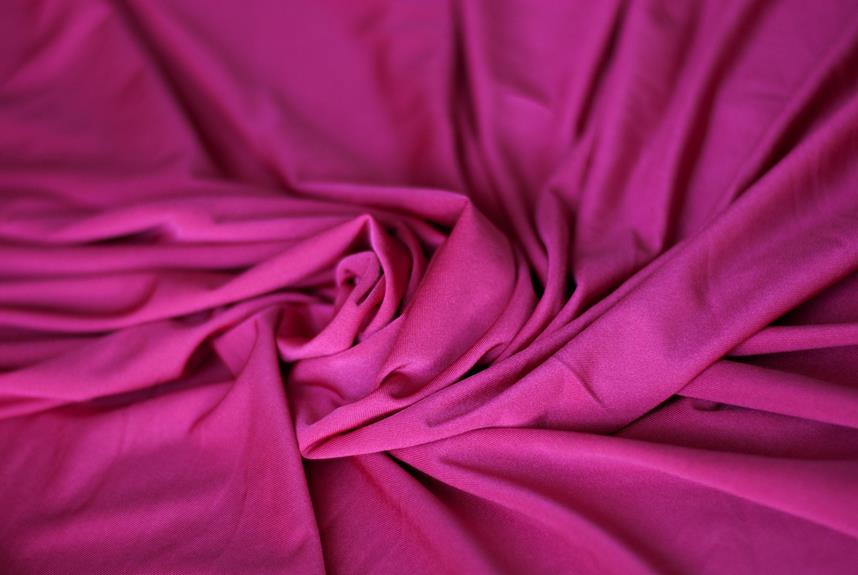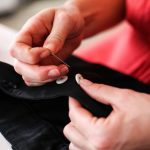When you're choosing between batiste and voile, it's essential to understand their unique qualities and applications. Batiste's softness and durability make it ideal for garments that require a bit of structure, while voile's sheer, airy nature lends itself well to summer dresses and light curtains. But how do you decide which one fits your project best? The nuances in texture and weight can significantly impact your final results, so let's examine the key differences that could influence your next sewing venture.
Table of Contents
Overview of Batiste
Batiste is a lightweight fabric that's often prized for its softness and breathability, making it ideal for a variety of applications. You'll find it commonly used in clothing, especially for blouses, shirts, and baby garments due to its gentle touch against the skin. It's typically made from cotton, linen, or a blend of fibers, which contributes to its delicate nature.
When working with batiste, you'll notice its fine weave, giving it a slightly translucent quality. This transparency makes it perfect for layering or creating soft, flowing silhouettes. You'll appreciate how easily it drapes, allowing for graceful movements in your designs.
Batiste's characteristics also make it a great choice for home décor items like curtains and lightweight bed linens. Its breathability ensures comfort in warm weather, so it's particularly sought after for summer garments.
Care is straightforward; most batiste fabrics are machine washable, though it's wise to check the specific care instructions for your fabric type. Overall, batiste offers a blend of elegance and practicality, making it a versatile option in your fabric collection.
Overview of Voile
Known for its sheer, lightweight qualities, voile is a popular choice for creating soft, flowing garments and elegant home décor items. You'll find it often used in curtains, blouses, and summer dresses, making it a favorite among fashion designers and crafters alike. The fabric's delicate texture allows for beautiful draping, which enhances its aesthetic appeal.
Here's a quick comparison to help you understand more about voile:
| Feature | Description | Usage Examples |
|---|---|---|
| Material | Often made from cotton or polyester | Dresses, blouses, curtains |
| Sheerness | Semi-transparent | Perfect for layering |
| Weight | Lightweight | Ideal for warm weather |
| Drape | Flows gracefully | Enhances garment silhouette |
| Care | Typically machine washable | Easy to maintain |
Voile's versatility extends beyond fashion, also enriching home décor with its airy feel. Whether you're sewing a chic summer outfit or dressing up your windows, voile brings an effortless elegance to your projects. By understanding its unique characteristics, you can choose the right fabric for your creative endeavors.
Key Differences Between Batiste and Voile
When comparing batiste and voile, you'll notice distinct differences in their texture, weight, and overall use in garments and decor.
Batiste is typically softer and finer, made from cotton or a cotton blend, giving it a delicate, smooth feel. This makes batiste an excellent choice for lightweight clothing like blouses and baby garments, as it drapes beautifully and feels gentle against the skin.
On the other hand, voile is a bit crisper and sheerer, often made from cotton or a cotton-polyester mix. It's slightly heavier than batiste, which gives it more structure. Voile's transparency lends itself well to layering, making it perfect for curtains, overlays, or dresses that need a little extra flair while still allowing light to filter through.
In terms of durability, batiste holds up well through washing and wear, but it may wrinkle more easily than voile, which tends to maintain its shape better.
Ultimately, your choice between the two fabrics will depend on the specific look and feel you're aiming for in your project, whether it be soft elegance or airy lightness.
Best Uses for Batiste
For a range of lightweight garments and delicate projects, batiste is an ideal choice due to its soft texture and elegant drape. You'll find it perfect for sewing blouses, dresses, and lightweight tops that require a gentle touch. The fine weave allows for breathability, making it suitable for summer wear or layering pieces.
Batiste also shines in creating delicate linings for skirts and jackets. Its lightweight nature ensures that it won't add bulk to your garments while providing a smooth finish. If you're into embroidery or appliqué, batiste serves as a fantastic fabric for these projects, as its softness allows intricate designs to stand out beautifully.
When it comes to baby clothes or children's garments, batiste's softness is gentle against delicate skin, making it a popular choice among parents.
Additionally, you can use batiste for home decor items like sheer curtains or lightweight tablecloths, adding a touch of elegance to your living space.
Best Uses for Voile
Voile is perfect for lightweight, airy garments like summer dresses and blouses, thanks to its soft texture and beautiful drape. This fabric not only feels great against your skin but also allows for breathability, making it ideal for warm weather.
Here are some of the best uses for voile that you might consider:
- Summer Dresses: Create flowy, comfortable dresses that keep you cool during hot days. The lightweight nature of voile helps the fabric float elegantly without weighing you down.
- Blouses and Tops: Make stylish blouses that can easily transition from casual outings to more formal settings. Voile's delicate drape gives a polished look that pairs wonderfully with skirts or trousers.
- Window Treatments: Use voile for curtains or sheer drapes. Its sheer quality allows natural light to filter through while still providing a level of privacy, perfect for bedrooms or living areas.
With its versatility and charm, voile can elevate your wardrobe and home decor. You'll love how it brings a light, airy feel to your creations!
Choosing the Right Fabric
When you're choosing between batiste and voile, it's crucial to consider their fabric compositions and how they fit your project.
Each fabric has ideal uses and specific care requirements that can affect the longevity of your creations.
Understanding these differences will help you make the right choice for your needs.
Fabric Composition Differences
Understanding the fabric composition differences between batiste and voile can help you make an informed choice for your sewing projects. Both fabrics have unique qualities that stem from their material and weave, which can affect your final product.
- Batiste is usually made from cotton or a cotton blend, giving it a soft, smooth feel. The fine threads are tightly woven, resulting in a lightweight fabric that drapes beautifully while still providing some structure. Its breathability makes it ideal for garments worn in warmer weather.
- Voile, on the other hand, is often made from 100% cotton or a cotton-polyester blend. It features a slightly looser weave, which creates a sheer and airy fabric. This transparency can add a lovely dimension to your projects but requires careful consideration when layering.
- The differences in composition mean that batiste tends to be more opaque and durable, while voile offers a delicate, flowing quality. Depending on your project, one fabric may be more suitable than the other, so take these composition differences into account for the best results.
Ideal Uses for Each
Which fabric is best suited for your project depends on the specific qualities you need, as batiste and voile each excel in different applications.
If you're looking for something lightweight yet structured, batiste is your go-to. It's perfect for delicate garments like blouses, dresses, and even lingerie, where you want a soft feel without sacrificing shape. Batiste's subtle crispness also makes it a great choice for linings and interfacing, ensuring your creations maintain their form.
On the other hand, if you desire a fabric that drapes beautifully and has a sheer quality, voile is the way to go. It's fantastic for flowy dresses, summer tops, and curtains that let in natural light while providing a touch of privacy. Voile's softness and translucence lend themselves well to layering, making it ideal for creating romantic, ethereal looks in your outfits.
Ultimately, consider the weight, drape, and texture you need for your project. By understanding the strengths of batiste and voile, you can choose the right fabric to bring your creative vision to life.
Care and Maintenance Tips
To keep your batiste and voile fabrics looking their best, it's essential to follow specific care and maintenance tips tailored to each material. By understanding the right ways to care for these delicate fabrics, you can ensure they remain vibrant and last longer.
- Washing: Always wash batiste and voile in cold water on a gentle cycle. This helps prevent shrinking and keeps the fibers intact. Avoid using bleach, as it can damage the fabric.
- Drying: Air dry your fabrics when possible. If you need to use a dryer, opt for a low heat setting to minimize the risk of heat damage. Remove them promptly to avoid wrinkling.
- Ironing: When it comes to ironing, use a low-temperature setting with steam. Placing a thin cloth over the fabric can help protect it from direct heat.
Frequently Asked Questions
Is Batiste More Durable Than Voile?
When comparing batiste and voile, you'll find that batiste generally offers greater durability due to its tighter weave. If you're looking for long-lasting fabric, batiste might be the better choice for your needs.
Can Batiste and Voile Be Washed Together?
You can wash batiste and voile together, but make sure to use a gentle cycle and cold water. This helps prevent any potential damage and keeps both fabrics looking fresh and vibrant for a longer time.
What Colors Are Available for Batiste and Voile?
You'll find batiste and voile in a variety of colors, from soft pastels to vibrant hues. They often come in classic shades like white, cream, and black, perfect for any project you have in mind.
Are Batiste and Voile Suitable for Outdoor Use?
When considering outdoor use, you'll find that both batiste and voile aren't the most durable options. They can fade and degrade in sunlight, so it's better to choose fabrics specifically designed for outdoor conditions.
How Do the Costs of Batiste and Voile Compare?
When comparing costs, you'll find that batiste often tends to be more affordable than voile. However, prices can vary based on quality and brand, so it's wise to shop around for the best deal.
- Troubleshooting Common Issues With Nonwoven Fabrics - July 11, 2025
- How Nonwoven Wallpaper Differs From Traditional Paper - July 11, 2025
- Are Reusable Nonwoven Bags Eco-Friendly? - July 11, 2025







